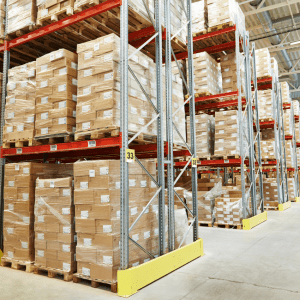Fire protection for cold storage facilities presents unique challenges due to the low temperatures and the materials stored. As the cold storage industry evolves and expands, so do the challenges for proper fire protection. A specialized approach is needed to prevent fire hazards while maintaining the integrity of the cold storage facility.
Cold Storage Fire Hazards
It seems unlikely that cold storage environments would pose a fire risk, but there are unique challenges present. The fuel and heat sources present in these warehouses can create a perfect combination of fire hazards.
- Stored Products: Some frozen foods and food coloring are considered combustible, and pose fire risks.
- Storage Materials: Packaging, such as cardboard and polystyrene, wooden pallets, and other storage materials can be highly flammable.
- Electrical & Lighting: According to the NFPA, 18 percent of warehouse fires are attributed to electrical distribution and lighting equipment. High-intensity discharge (HID) lighting, in particular, poses a fire risk as a heat source.
- Refrigeration: Refrigeration equipment presents an electrical fire hazard, as well as the presence of ammonia as an accelerator.
- Materials & Machinery: There are many other fire hazards in cold storage, such as insulation, machinery (such as forklifts or conveyors), and maintenance work (such as welding).
Cold Storage Fire Protection Systems
The proper fire suppression system depends on the type of cold storage facility. Warehouses can be fully conditioned and insulated (big-box), or a refrigerated space inside a larger warehouse (box-in-box). Box-in-box facilities can combine a wet sprinkler system with a specialized suppression system in the refrigerated space. Typically, these suppression systems are installed in the ceiling, in the storage racks, or a combination of both. The fire suppression systems used for cold storage include:
- Dry-Pipe Sprinkler Systems: Due to the risk of freezing pipes, traditional wet-pipe sprinkler systems are not suitable for cold storage. Dry-pipe sprinkler systems are filled with pressurized air or nitrogen, and only release water into the pipes when a fire is detected.
- Double Interlock Pre-Action Sprinkler Systems: The piping in these systems, like dry-pipes, are filled with air or nitrogen. Before releasing water, a double interlock pre-action system requires both the fire detection system to activate, and the sprinkler heads to be activated by heat. This helps prevent accidental discharge, which can be very expensive.
- Foam Suppression Systems: In some cases, foam-based fire suppression can be more effective, especially when dealing with flammable liquids or materials that might be present in cold storage.
- Tyco Quell Fire Sprinkler Systems: This ceiling-only suppression system is designed for increased height coverage (up to 55 feet high) to maximize cold storage volume. This system uses a “surround and drown” method. Quell systems are only available through trained and authorized fire sprinkler professionals.
Fire Detection Systems
- Aspirating Smoke Detection (ASD): These systems are designed to detect fire in its early stages by continuously sampling the air in an area. They can differentiate smoke from other factors that could cause false alarms.
- Smoke Detectors: Installing smoke detectors that can function effectively at low temperatures is crucial. These detectors should be suited to the environment, where humidity and freezing temperatures can affect performance.
- Heat Detectors: These can be more reliable in environments where cold air currents may impact smoke detection. Rate-of-rise heat detectors or fixed-temperature heat detectors can be used, depending on the specific conditions of the storage area.
Facility Materials and Construction
The insulated panels used in cold storage facilities often contain foam, which can be highly flammable. Fire-resistant materials and properly sealed joints can help reduce fire spread. Seal integrity is essential in box-in-box facilities to reduce condensation and ice buildup. Also, creating fire-resistant compartments within the facility can prevent a fire from spreading rapidly. Proper fire doors and barriers between sections of the cold storage can enhance protection.
Fire System Maintenance and Testing
Proper installation of cold storage fire protection systems is important to achieve full functionality. After installation, ensuring that fire suppression systems, particularly those with dry-pipe components, are regularly inspected and maintained is critical to prevent malfunction. Regular testing of the fire protection systems, including fire alarms, sprinklers, and suppression systems, ensures they function correctly in low temperatures.
Emergency Preparedness
Employees working in cold storage facilities should be trained on fire evacuation procedures, including the use of fire extinguishers and responding to alarms. Ensure that the facility has adequate access points for firefighters. Special gear or procedures may be required for first responders.
Compliance with Standards
NFPA 13, Standard for the Installation of Sprinkler Systems, includes a range of design standards for cold storage and other special environments. Also, ensure compliance with local fire protection codes and standards, which may have additional requirements for cold storage facilities.
Consult with a Fire Protection Company
Proper planning, specialized systems, and regular maintenance are crucial for effective fire protection in cold storage environments. Cogswell Sprinkler Company is a Quell system licensee, and is uniquely positioned to offer the cold storage industry installation and service of this innovative system. Cogswell Sprinkler is a full-service fire protection company serving Massachusetts and the New England area. Through their family of companies, they can provide fire protection throughout the nation. Contact Cogswell Sprinkler for cold storage fire protection solutions!
